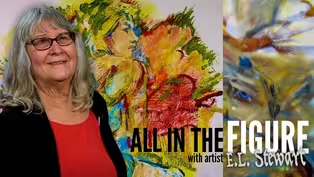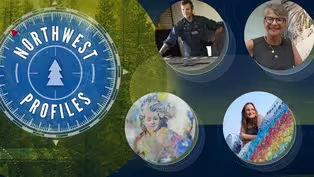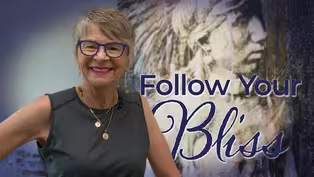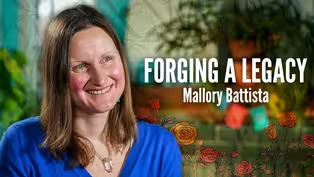Northwest Profiles
MAY 2024
Season 37 Episode 3706 | 24m 12sVideo has Closed Captions
Glassmaster Alex Brannin; artists E.L.Stewart, Barb Schwarz Karst, and Mallory Battista.
A collection of talented artists are profiled this month. Glassmaster Alex Brannin designs breathtaking stained glass art; painter E.L. Stewart dazzles with her free-flowing figures; Missoula artist Barb Schwarz Karst blends traditional materials with edgy and unconventional media; and Mallory Battista does it all...comics, murals, prints, even ironwork. Don't miss our Season 37 finale!
Problems playing video? | Closed Captioning Feedback
Problems playing video? | Closed Captioning Feedback
Northwest Profiles is a local public television program presented by KSPS PBS
Funding for Northwest Profiles is provided by Idaho Central Credit Union, with additional funding from the Friends of KSPS.
Northwest Profiles
MAY 2024
Season 37 Episode 3706 | 24m 12sVideo has Closed Captions
A collection of talented artists are profiled this month. Glassmaster Alex Brannin designs breathtaking stained glass art; painter E.L. Stewart dazzles with her free-flowing figures; Missoula artist Barb Schwarz Karst blends traditional materials with edgy and unconventional media; and Mallory Battista does it all...comics, murals, prints, even ironwork. Don't miss our Season 37 finale!
Problems playing video? | Closed Captioning Feedback
How to Watch Northwest Profiles
Northwest Profiles is available to stream on pbs.org and the free PBS App, available on iPhone, Apple TV, Android TV, Android smartphones, Amazon Fire TV, Amazon Fire Tablet, Roku, Samsung Smart TV, and Vizio.
Providing Support for PBS.org
Learn Moreabout PBS online sponsorshipHello and welcome to this edition of Northwest Profiles.
I'm your host, Lynn Veltrie, and it's great to have you with us as we wrap up another successful season of profiles.
Now, you might be wondering, how do we measure our success?
Well, it's easy because from the start, well over three decades ago, our intent was to deliver a show that would capture the vitality, creativity, and in many ways, the heart and soul of our home.
A vast community stretching across four states and two provinces of Canada.
And so when we reflect on this year's collection of stories, it's clear, thanks to a dedicated team of producers and wonderful viewers like you, we once again achieved our goal.
And to prove it, we finish off our 37th year with a season finale bursting with creativity and craftsmanship.
For our first story, we head to Spokane Valley to meet Alex Brannin, a custom glass craftsman who has been working with the sharp yet beautiful media ever since he could walk.
So my dad, basically self-taught himself through, salvaging old panels out of a long neglected neighborhood and opened up big shop.
So about the time I was four years old, I was down there running tools around and learned how to cut glass and stuff.
Jerry Brannin, Alex's father, opened American Art glass in 1971, in Norfolk, Virginia.
It quickly became a cherished local institution and where Alex learned the craft from his father.
Something I was born into and something I was sort of, groomed to follow, so In 2012, Alex met his wife in Virginia, who was a Spokane native.
Soon after, they decided to move American Art Glass to Washington State near Elk.
However, Alex decided he needed a hiatus from the business and became a farmer for six years.
His wife, Colleen sent an email to Spokane's Historic Preservation Office letting them know Brannin was in town if his skills were ever needed, which they soon were.
When the Otis Hotel was being renovated into Hotel Indigo and their 100 plus year old leaded windows needed repair.
In 2019, Alex moved the shop to Spokane, which eventually became Spokane Stained Glass.
The stained glass has its just own an entire realm of fascinations.
I'm in between the the history, the craftsmanship.
the subject matter, obviously.
Colors.
just one of my favorite examples in town would probably be, Saint John's Cathedral.
Up on the hill there.
that building is stunning.
I'd say one of the other things that's probably interesting about glass are the people that make it.
Or are involved with it in the scope of the glass world.
According to the Stained Glass Association of America, the earliest known manmade glass is in the form of Egyptian beads from around 2700 BC.
In the first century A.D., the Romans glazed glass into windows, and one of the oldest known examples of stained glass used in a window is at a monastery in England.
Founded in 686 A.D. Stained glass comes in three basic forms today, leaded, art and faceted.
The biggest challenge in working with stained glass.
probably assessment of historical things, because it becomes pretty time consuming and it has to be pretty in-depth, just to make a proper approach to say like a larger scale project, it's just survey time, but at the same rate.
That challenge is so much fun.
It's, possible to look at it as a challenge half the time.
Alex enjoys preservation and restoration, but there's a distinct difference between the two.
We're talking some heavy history.
Things don't necessarily need to be rebuilt, but, you know, are in need of obviously some help to, live another hundred years or so.
I mean, that's your preservation end of things.
And, restoration a lot of times comes down to, like, matching, broken, damaged pieces of glass, rebuilding structure, things like that.
Hands on history, dealing with something that somebody built out of some little sawmill 120 years ago.
Always enjoy the opportunity to get my hands on something that's about four times older than I am.
Besides repairing and restoring glass pieces.
Alex spends about half of his time on custom jobs.
Custom things are probably what I'd like to stay busiest with, just because there's a lot of fun opportunities there.
Kind of twist people's arms design wise.
Come up with something fun.
It's just always cool to take somebody's interpretation and, you know, realize that into a glass piece, With the help of Alex's wife.
Spokane stained glass has been branching out to grow the business and to capture renewed interest in the craft like offering classes.
So they're essentially, a beginners fuzed glass class, and we're, taking a single layer of glass and adding more glass to it.
glass powders, different colors, strings of glass.
take those back to the other studio, fire them in the kiln, and, return these people's finished products.
To their amazement.
So.
Well, that's the fun part about kiln work, because I tell everybody that it's, it's hard to put anything in the kiln and have it come out ugly.
we're trying to trying to expand, more or less.
We'd like to get to a point of, having a lot more glass and stock, have a bit more of an online presence.
we aspire more or less, to give the kids something good to take over.
Alex also knows there are fewer custom glass craftsmen in town.
One just, declared himself retired.
So I think a lot of his repair work has been finding its way over here.
Ever since I was a teenager, people walk in the shop and say, isn't this a dying art?
And, my contention was always no, until I started, paying a little bit more attention and growing up into it.
And I'd say it, definitely is probably in the same way, like, a lot of traditional craftsmanship.
And maybe because there are less craftsmen, Alex has found himself to be busier than ever.
My wife keeps saying, these are all stresses that we're thankful for right now, because I'm just as busy as a bee.
And, I think this is probably the the busiest the shop has been since I was a knee high or so.
For Alex, he still finds inspiration in glass.
Glass is magic stuff.
I mean, just in terms of the kiln work.
I mean, you put something in, you get something completely different out, or.
I mean, it's ever evolving.
I learn something probably every day about it.
So in the, Disney sense of things, it's a very magical, very magical thing.
Wow.
Spectacular, indeed.
By the way, Alex has recently brought on an apprentice and is looking forward to moving to a larger location in Spokane Valley sometime soon.
Now we transition from art and glass to art on canvas.
There are many artists who specialize in painting the figure, but we found an artist here in Spokane whose work stretches the boundaries of her subjects while creating boundless emotion in her images.
At her easel, Spokane artist Elsie Stewart methodically paint some of her recent favorite subjects trees.
I started doing trees because it's so, they're so human like, you know, and I can express a lot through trees.
Some people can see it as being a, personification.
A lot of people don't see it.
They just see it as a tree.
Born and raised in Michigan to Lewis and Charlotte Dodd, Elsie quickly realized she had a passion for the arts, with both parents being artistic.
They raised their children in a household that celebrated that.
My mother, she played violin, and in her younger days she tap danced with her sister.
My dad was an artist.
He'd encourage me and and the rest of my siblings and we all, we all became artists, actually.
Or musicians.
Elsie, after pursuing an education in art, hitchhiked and settled in Spokane in the early 1970s, bringing with her an artistic sensibility that has grown through the years since beginning her career as an artist in the late 1960s.
Elsie, also known as E.L., began using her initials to identify herself so she wouldn't highlight her gender.
I found that if I used my initials, it worked a lot better for me for getting into any kind of a show, you know, as long as I kept my gender a secret and it served me well and I just kept with it all these years.
I started out with crayons, of course, but, my dad gave me an oil set when I was probably about 12.
My dad was a wonderful man.
My dad was a figure painter.
So we had we had nudes all over the house.
I mean, they were everywhere.
And I started doing figure.
You know, my dad instilled a real love of of art and in figure painting for me.
I just think it's great and I'll always keep it.
I carry it on.
I've always painted dark.
Kind of dark because I think it's because my dad always painted dark.
And that's just the way I learned to do it.
And now I'm trying to lighten things up a little bit.
So I've been using some some of these, you know, oranges and blues things together and I rather like it.
We'll see what I'm doing next week.
I don't know.
When Elsie paints, she rarely uses lines.
When she begins her paintings by using her gift of intuition as a guide.
She frequently creates images on the canvas, freeform, making decisions as she goes.
There's times where I just have to paint something out and paint something else in and the painting evolves.
Yeah, like the, like the painting up there.
It started out as a a dog chasing a rabbit through a garden was my initial idea.
Now it's called crow.
And I love it when people when people really see it and can see something in it that makes a connection with them.
That's very important to me.
Very important.
I put a lot of a lot of passion and a lot of emotion.
Into it because.
It just fires me up so much.
But I know that doing art is something, something beautiful.
In that there's people that can see it for the for the life giving essence that it has.
And I'm just really pleased to be able to to do that well and to, to just, have my work appreciated and lived with and loved, you know, and held in esteem.
For our next story, we stay focused on the art of painting with a trip to Missoula, Montana, where through the inspired work of an artist who has the unique ability to blend traditional materials with edgy, unconventional media, we discovered a fresh approach to art and painting.
Nothing is ever completely black or white.
We operate in a gray zone.
It's that acceptance of how we can coexist with each other and figure out what's best for the world.
Hi, my name is Barb Schwarz Karst, and I'm a professional painter, and I live in Missoula, Montana.
Barb Schwarz Karst, originally trained as a photo realist, but now works mostly in abstract and mixed media artwork.
I don't make pretty art.
I just don't.
I want art that actually has some meaning or some tooth behind it.
Barb is best known for her Shifting Winds, Stark Unreality, Crucibles, and Montana Rust Belt collections.
This is my Crucibles series, so these are all people that have influenced me, either with their music or with their art.
So you see, Tom Petty, you see, this Kurt Cobain and I call this In the Pines.
This is actually chrome and aluminum that was in a fire and it melted off of old junk automobiles, and then it pooled into the dirt and made these abstract shapes.
So this is part of the Shifting Wind series.
And this one's called Baptism by Fire.
And it, I don't know if you can see it, but it's highly, highly textured.
And then the underpainting I did in a lot of really hot oranges and reds.
I'm trying to pay a lot of respect to indigenous peoples.
Even as a kid, I wanted to do art.
I think because I grew up fairly poor and we didn't have a lot of materials to work with.
So I always, I remember distinctly making my own paints.
My mother always was encouraging me to go into art but I, I didn't know whether I wanted to or not because I was a little afraid of not being able to make a living from it.
When Barb was in college, she started out as an elementary education major, but during her third year of school, she took a few art classes.
That changed everything.
One of my professors pulled me in and had me speak to the department chair.
He saw my work and said, you should transfer and you should become an artist.
After college, Barb taught high school art for 25 years, which gave her the flexibility to continue working on her own art.
It was a good profession for me.
I was always able to do my art, even when I was teaching, and I've always had a love for it.
Even as a kid, I just loved art.
I have this entire painting covered and I only paint that one section at a time.
I came up with that.
It's called a blind grid, so I do the underpainting and then I use pencil and I grid the entire piece, like with these shapes.
What happens is when you unveil it, things won't quite match up.
You're going to see kind of edges that don't completely match up, because I can't see what's in the adjacent piece, and it kind of gives it a weird tension and almost movement.
From 2003 to 2004.
Barb received a fellowship to study with TICA, or Teacher's Institute of Contemporary Art through The School of the Art Institute of Chicago.
It was a complete switch for me.
That's when I started leaning more into, I'm going to do abstract art.
I mean, I love this, this is freeing for me.
And and so I've seen it, you know, change over the years.
But that was a big pivotal, you know, point for me.
Barb's piece “Warrior” won an award in New York at the National Society of Painters in Casein and Acrylic.
Im pretty honored.
I mean, I've had lots of people buy my artwork, and every time they do it, it makes me happy.
I also did a painting of Gary Clark Junior, who's like one of my favorite musicians of all time, and, and was actually able to, meet him and, and, I gave him the piece of he owns it now personally, that stands out in my mind.
Barb has one piece of advice for aspiring artists.
Follow your bliss.
And not to blow it off and think I'm not good enough.
I would never be able to do that.
I could never paint as well as this person, or I could never sing as well as this person to just do that, because it's so inspiring and and just, I think it really grounds people.
You're never too old.
You just, you know, you need to follow your bliss no matter what and share that with other people.
See, you're the artist at work now.
Now for our final story.
Prepare to meet the incredibly versatile visual artist Mallory Batiste.
From murals to comics to prints and ironwork, she does it all with a drive for diversity and a fire for creativity.
Well, I've always wanted to be an artist.
I get told the story that I was trying to sell my finger paintings at four years old, apparently, for a quarter apiece.
[Music] It is kind of difficult to figure out how all of the things that I do sort of connect with each other.
I've had a hard time sort of pinpoint like, what is my style?
I have a lot of different interests, and they think that that variety has sort of kept everything interesting.
I don't like making the same thing over and over again.
So, um, every, every project I take on, I try to kind of push myself a little further, you know, experiment with new materials and kind of keep it interesting.
Like most folks, I do some painting.
Um, I like to work in acrylics.
Um, I like to paint murals.
Both interior with regular house paint and exterior with, uh, with spray cans.
Ah, I like working with metal, so I have been blacksmithing for the last ten years.
Uh, one of my great loves is stained glass.
Um, so I've, I've started trying to incorporate that.
I recently, uh, did my first mosaic sculpture, which was really fun.
Um, so I try to work in a lot of different things.
[Music] So, I heard someone say one time that the, the medium isn't the message.
And at first I was kind of, like, resistant to that because I get really excited about different materials.
But it's really true.
You know, the medium isn't the message.
Like you have to have like a concept that you're trying to get across, or at least I do to for my work to feel meaningful.
And so for me, like at this point, I really pick the materials that I feel like are going to portray whatever it is that I'm trying to accomplish in the best way possible.
[Music] So I feel like, with my progression as an artist, I feel like I sort of, like, snuck in through the back door.
[laughs] Um, I sort of started out doing these, like, really niche things like, like blacksmithing and and drawing comics, but like, those were probably the two things that really, plugged me into the, the local art community.
And making friends with blacksmiths that actually, you know, had shops and would let me come out and dink around in their shops and make stuff and one of my favorite things that we do as a club, is we do this blacksmithing at the library event with the Spokane County Library.
And it's, it's so cool because, I mean, while we try to keep our classes really affordable through the club at the library, you get to come for free with your library card, and walk away with, you know, a hook or a pin or, you know, whatever project you choose.
And I think it's so wonderful to be able to have it be so accessible to the community.
And I so enjoy introducing people to forging for the first time.
Getting to work with hot metal is just, it's just exhilarating.
It's just such an interesting material and and it's just really fun to get to, to share that with other people.
[Music fades] [Music builds] Public art is it's such an important part of a city's personality, right?
I think that it's our responsibility, as a city, as, you know, citizens here to consciously create the place that we want to live and so I think that's one of the things that it's so exciting about creating public art, because I get to kind of help, you know, determine what is that esthetic, what is the personality of the space that we as a community share?
Like I feel like there's a, there's a little bit of a responsibility when you're making art that's going to be in the public that you're thinking of the audience that will be interacting with it the most.
What's special about this particular space?
What's, what's something that would mean something to the people that are here most often, you know, theres something just really exciting about going out into the world and helping, kind of, elevate, you know, how do we enjoy these spaces that we share?
[Music full] Now, if you're looking, you can spot the variety of Mallory's work all around Spokane.
And of course, you can stay up to date on Mallory's latest projects by checking out her website.
And on that note, we've finished celebrating not only artistry at its best, but also the end of our 37th season.
It's truly been a terrific year thanks to the fine work of all the profile producers, including Scott McKinnon, Todd Anderson, Neil Vanos and McKayla Fox.
For now, until we see you again next season.
This is Lynn Veltrie saying happy trails.
And keep in mind, with a vacation season upon us, it's the perfect time to check out our home region.
So go exploring.
And as always, when you do, take time to enjoy the view.
E.L. Stewart: All in the Figure
Video has Closed Captions
Clip: S37 Ep3706 | 4m 52s | Elsie Stewart, an expressive figure painter that revels in creating art that is packed with emotion (4m 52s)
Video has Closed Captions
Preview: S37 Ep3706 | 30s | Glassmaster Alex Brannin; artists E.L.Stewart, Barb Schwarz Karst, and Mallory Battista. (30s)
Follow Your Bliss: Barb Schwarz Karst
Video has Closed Captions
Clip: S37 Ep3706 | 5m 24s | The Missoula based artist who blends traditional elements with innovative and unconventional ideas. (5m 24s)
Forging a Legacy | Mallory Battista
Video has Closed Captions
Clip: S37 Ep3706 | 4m 40s | Learn about Mallory Battista, an artistic powerhouse driven by the fires of creativity. (4m 40s)
Providing Support for PBS.org
Learn Moreabout PBS online sponsorshipSupport for PBS provided by:
Northwest Profiles is a local public television program presented by KSPS PBS
Funding for Northwest Profiles is provided by Idaho Central Credit Union, with additional funding from the Friends of KSPS.


















